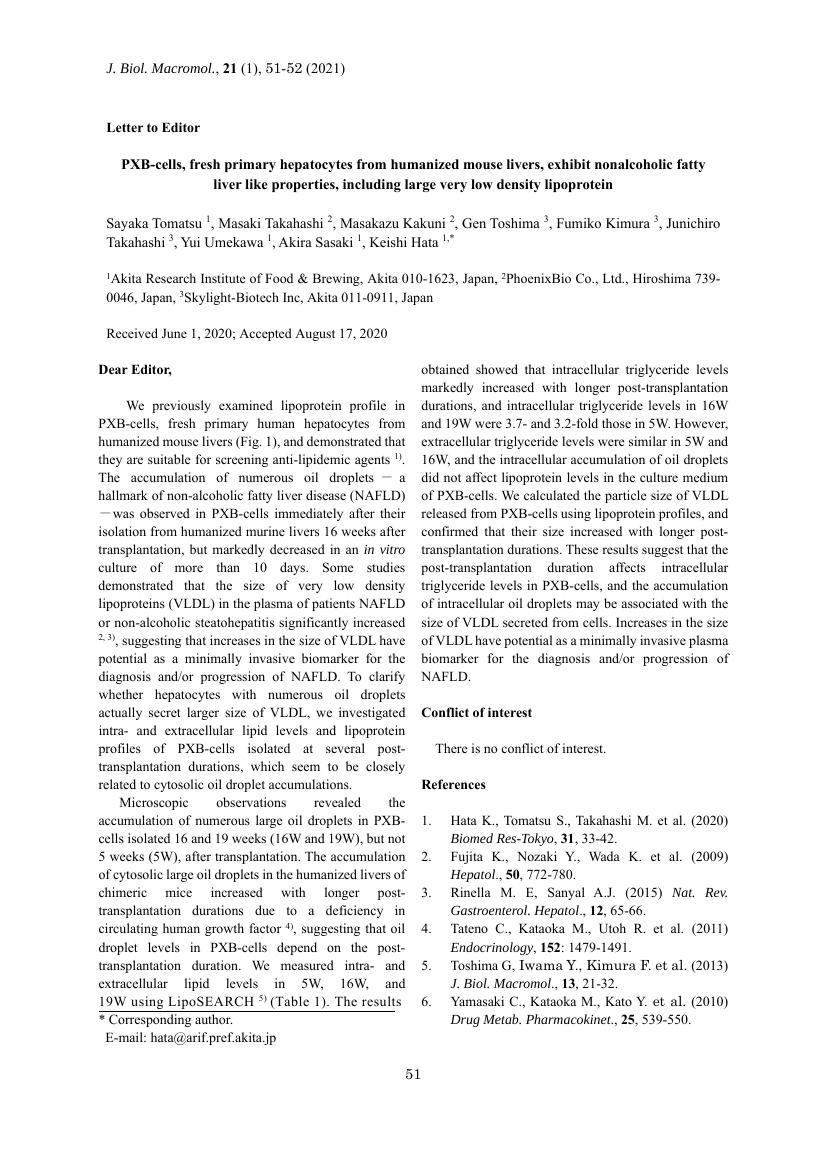2 0 0 0 OA Yamabushitake Mushroom (Hericium erinaceus) Improved Lipid Metabolism in Mice Fed a High-Fat Diet
- 著者
- Kazuyuki HIWATASHI Yasuyuki KOSAKA Nao SUZUKI Keishi HATA Toshiyuki MUKAIYAMA Kenji SAKAMOTO Hitoshi SHIRAKAWA Michio KOMAI
- 出版者
- Japan Society for Bioscience, Biotechnology, and Agrochemistry
- 雑誌
- Bioscience, Biotechnology, and Biochemistry (ISSN:09168451)
- 巻号頁・発行日
- pp.1006011996, (Released:2010-07-07)
- 参考文献数
- 20
- 被引用文献数
- 42
The effects of dietary Yamabushitake mushroom (Hericium erinaceus) on lipid metabolism were examined. C57BL/6J mice were fed a high-fat diet containing hot-water extract (HW-E) and an ethanol extract (EtOH-E) of Yamabushitake mushroom. Administration of HW-E or EtOH-E with a high-fat diet for 28 d resulted in a significant decrease in body weight gain, fat weight, and serum and hepatic triacylglycerol levels. Our in vitro experiments indicated that EtOH-E acts as an agonist of peroxisome proliferator-activated receptor α (PPARα). Quantitative analyses of hepatic mRNA levels revealed that EtOH-E administration resulted in up-regulation of mRNA for a number of PPARα-regulating genes in spite of the fact that the gene expression of PPARα did not change. These results suggest that EtOH-E improves lipid metabolism in mice fed a high-fat diet, and that these effects were mediated by modulation of lipid metabolic gene expression, at least in part via activation of PPARα.
- 著者
- Sayaka Tomatsu Masaki Takahashi Masakazu Kakuni Gen Toshima Fumiko Kimura Junichiro Takahashi Yui Umekawa Akira Sasaki Keishi Hata
- 出版者
- Japan Science Society of Biological Macromolecules
- 雑誌
- Journal of Biological Macromolecules (ISSN:13472194)
- 巻号頁・発行日
- vol.21, no.1, pp.51, 2021 (Released:2021-01-20)
- 参考文献数
- 6
- 著者
- Keishi HATA TOMATSU Sayaka Masaki TAKAHASHI Akira SASAKI Yui UMEKAWA Kazuya MIYASHITA Kazumi OGURA Gen TOSHIMA Masahiro MAEDA Junichiro TAKAHASHI Masakazu KAKUNI
- 出版者
- Biomedical Research Press
- 雑誌
- Biomedical Research (ISSN:03886107)
- 巻号頁・発行日
- vol.41, no.1, pp.33-42, 2020-02-01 (Released:2020-02-22)
- 参考文献数
- 24
- 被引用文献数
- 5
We investigated lipid metabolism in PXB-cells, which are human primary hepatocytes isolated from liver-humanized mice, and HepG2 and HuH-7 human hepatoma cell lines. Lipoprotein levels were higher in PXB-cells than in the 2 other cell lines, and PXB-cells mainly released triglycerides and cholesterol as very low density lipoprotein (VLDL), similar to actual liver tissue, whereas the major lipoprotein released from the 2 hepatoma cell lines was LDL. RT-PCR analysis demonstrated that the gene expression levels of apolipoprotein B100 (ApoB100), the apolipoprotein of VLDL/LDL, were similar in PXB-cells and HepG2 cells, while the overexpression of ApoC2, ApoC3, and ApoE, which are components of VLDL, but not LDL, was observed in PXBcells. A protein immunoassay revealed that ApoB100 levels secreted from PXB-cells and HuH-7 cells were similar; however, ApoC3 levels were higher in PXB-cells than in the two other cell lines. We also examined the anti-lipidemic activities of fenofibrate using this assay system. Fenofibrate suppressed lipoprotein production from PXB-cells in a dose-dependent manner mainly by activating the β-oxidation pathway. These results suggest that PXB-cells produce high levels of lipoproteins and are suitable for screening anti-lipidemic agents.
1 0 0 0 OA Yamabushitake Mushroom (Hericium erinaceus) Improved Lipid Metabolism in Mice Fed a High-Fat Diet
- 著者
- Kazuyuki HIWATASHI Yasuyuki KOSAKA Nao SUZUKI Keishi HATA Toshiyuki MUKAIYAMA Kenji SAKAMOTO Hitoshi SHIRAKAWA Michio KOMAI
- 出版者
- Japan Society for Bioscience, Biotechnology, and Agrochemistry
- 雑誌
- Bioscience, Biotechnology, and Biochemistry (ISSN:09168451)
- 巻号頁・発行日
- vol.74, no.7, pp.1447-1451, 2010-07-23 (Released:2010-07-23)
- 参考文献数
- 20
- 被引用文献数
- 42
The effects of dietary Yamabushitake mushroom (Hericium erinaceus) on lipid metabolism were examined. C57BL/6J mice were fed a high-fat diet containing hot-water extract (HW-E) and an ethanol extract (EtOH-E) of Yamabushitake mushroom. Administration of HW-E or EtOH-E with a high-fat diet for 28 d resulted in a significant decrease in body weight gain, fat weight, and serum and hepatic triacylglycerol levels. Our in vitro experiments indicated that EtOH-E acts as an agonist of peroxisome proliferator-activated receptor α (PPARα). Quantitative analyses of hepatic mRNA levels revealed that EtOH-E administration resulted in up-regulation of mRNA for a number of PPARα-regulating genes in spite of the fact that the gene expression of PPARα did not change. These results suggest that EtOH-E improves lipid metabolism in mice fed a high-fat diet, and that these effects were mediated by modulation of lipid metabolic gene expression, at least in part via activation of PPARα.
